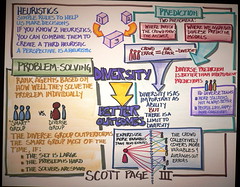Whenever we learn anything we are influenced by other people, as well as by our culture, our beliefs, experiences we’ve had, the understandings we’ve developed about the world and the way it works, and our current context. Every human being’s learning is therefore shaped by the people around them, even when they are not directly seeking to learn collaboratively. Language and the way we use it to communicate plays a large part in shaping our experiences, especially in the online world.
I suspect that most have us have been misunderstood when they have sent an email, posted a comment in an online forum, or typed up a blog post. Why do these misunderstandings arise? Nancy White (2000) highlights 5 key differences between face-to-face and/or real time (synchronous) communication, and communication where there is a time delay between the initial communication and the reply (asynchronous):
-
No visual cues - this means that as you type you will not be able to pick up on the physical cues you are used to receiving in face-to-face contexts. Written language can be quite slippery, and something you may have meant to be lighthearted, may be read as something totally different.
-
Delayed response - you are likely to be used to this from text messaging and emails. Sometimes, however, the delay might be exceptionally long, or you may not receive a reply at all. There are also group dynamics where a community member contributes a lot, or logs in, reads but does not leave a comment or reply (lurking).
-
Illusion of distance - most of us have done it...sent a communication that we’ve instantly regretted but can’t retrieve. Often it’s something we’d never say if we were in the same room as the person, and as such is outside of social norms.
-
Biased toward writers - while it is becoming easier to communicate using audio and video, novices to online learning communities tend to start with text-based communications. This puts those with less developed literacy skills at a disadvantage.
-
Public versus private - some community members may have quite strong views about what should be public and what should be private; for example, some members will not want to reflect critically about a skill they have trialled or an experience they have had.
So now we have looked at some of the key differences, we can now explore some of the strategies we can use to 1) help encourage positive dialogue in online spaces, in part by modelling responses; 2) minimise the risk of misunderstandings and communications that go awry; and 3) ensure that we don’t inadvertently ‘shut down’ discussions.
Encouraging positive, ongoing dialogue and participation
The following examples are only a very few suggestions and models of approaches you might use (adapted from Anderson, et al, 2001, p. 8) . There are many others, and I would be delighted if this grew into a much bigger resource with a broader range of ideas...so, please add you’s in the comment box below :-)
- Identifying areas of conceptual / theoretical agreement/disagreement: "@Xu Lin, Janelle has provided some compelling suggestions that seem to take a rather different stance from your’s. It would be great if you had the time to respond to her?"
- Seeking to reach consensus/understanding: "It feels to me like Martin and Whare are, in essence saying essentially the same thing :-)"
- Encouraging, acknowledging, or reinforcing contributions: "Thank you for your insightful comments"
- Setting climate for learning: "@Manu - I love the fact that you are 'thinking out loud' in this conversation. It’s great to be able to follow the flow of your thoughts. Would be good to hear if you reached a final conclusion ;-)"
- Drawing in participants, prompting discussion: "Any thoughts on this issue?" "Anyone care to comment?". Alternatively, you might want to ask quite specific questions that encourage, for example, the write of a blog post to dig a bit deeper: “The experience you describe here is heartening. I was wondering, though, did you see specific shifts in student writing while they were using Storybird? Were students interacting differently than when they were using pens and paper?
- Unpick resources, ideas and comments: "In the video Black says [insert provocative quote]…what do you think? Do you agree / disagree? Have you had similar experiences?"
- Focus the discussion on specific issues: "Hmmm - I wonder; it feels as though...[insert specific issue] has been explored a lot in the media, but I am not sure that I agree with the coverage that has been given, because...[select a specific aspect of the issue] "
- Summarise discussions: "The original question was …Krishna said...Nigel then responded...and Togi concluded that…. But I feel as though we haven't addressed…"
- Explore understanding / suggest explanations.: "I feel as though you are pretty close in your interpretation of …[insert topic / theory / concept here], but I’m not sure you accounted for… …and I feel this is important because…”
- Gently highlight what may be misconceptions: "While it sounds as though from a senior management perspective this is likely to be a positive way forward, but I’m not so sure it holds true in other roles…for example, when I was...what do you reckon?"
- Share ‘knowledge’ from diverse sources, e.g., videos, articles, podcasts, personal experiences (and include pointers to resources): "I was out running and listening to a podcast, where Gilly Salmon was saying …If you are keen to listen to the podcast in full, you can find it at http://www…."
- Responding to technical concerns: "If you want to include a hyperlink in your message, you need to . . ."
 A few more tips (from the Australian Flexible Learning Network) for fostering a safe and engaging online community area include:
A few more tips (from the Australian Flexible Learning Network) for fostering a safe and engaging online community area include:-
Sound like yourself, use a 'genuine' voice and model the style and tone of the 'conversation' you would like to see from other online members.
-
Explore useful communication such as how and when / if to use acronyms and emoticons (smilies).
-
Use plenty of white space and if you can, use different colours and fonts to enhance clarity and identify key pieces of information.

Roles for effective facilitation
You might be involved in facilitating an online community, and the following are some proposed roles and functions (suggested by Feenberg and Xin, n.d.) that can help you identify on what your purpose is, and so select positive language to match that purpose.
-
Meta Functions: in your role as facilitator you can help foster conditions required for good communication; watch multiple conversations and weave common threads between participant comments, offering prompts and summary when important; help address issues around information overload; summarise, and compare, and contrast different points of view.
One of the issues here is that you “run the risk of wresting ownership of the dialogue from its contributors” (Collison et al., 2000, p. 141). So, often you will need to leave the community members to formulate questions that will deepen the dialogue, while you also “avail yourself of techniques that explore tensions without seeking resolution, examine rationale for beliefs or assumptions without assigning value” (Collison et al., 2000, p. 141).
-
Contextualizing: this is where, as a facilitator, you provide context; select themes or questions for discussion (or sets up a process for community members to do this); open discussions; model interactions and behaviours; share your own experiences; set the tone; and refer to resources or links to extend thinking or that might be useful for community members.
-
Monitoring: in this role, you recognise community members’ contributions; help keep the momentum going in discussions if necessary; and prompt contributions by posing new questions.
As part of monitoring, you will need to acknowledge contributions from every member at some point - this is a bit of a balancing act though, and you don’t want to become the sole voice or the person who always replies.
Positive reinforcement can be very powerful, but remember that by publicly praising a participant you can shut down further dialogue. Other participants reading your message of approval may think: ‘I don’t think I can really add to that’, or your message may create anxiety if other participants think: ‘Why didn’t (s)he respond similarly to my message?’.
Cultural responsiveness
In online communities, as in any other community, there are ethical issues of respect for one another regardless of gender, ethnicity, religion, class and age. As such, as members of an online community, we need to be culturally responsive, and to be aware of the diversity of community members. While this list is not exhaustive, some things to be aware of are,
-
some content may be sensitive – for example, politically correct in one culture but offensive in another culture
-
a request for community members to upload an image of themselves would be inappropriate for some cultures (an image of something that interests them may be OK though)
-
language used may potentially reinforce cultural stereotypes
When posting and/or responding in an online community you may want to look for resources that represent more than one cultural viewpoint.
And remember - recognising that participation in an online community cannot be culturally neutral is the first step in the process of becoming culturally competent (Palloff & Pratt, 2003, p. 41).
There are many more and it would be excellent if you make suggestions (or relate your own experiences) in the comment box below.
Additional resources
-
Avoiding Online Conflict (Moussou, & White, 2004) - provides 4 tips for avoiding online misunderstandings. It also includes some great questions for you to think about in connection with your facilitator roles and responsibilities when a community is experiencing negative behaviours.
-
Wheeler’s blog post, Lurking and loafing (2010), is worth reading in full if you have the time.
-
Let's get more positive about the term 'lurker' looks at the value of lurking, resistance to lurking, and why lurkers ‘lurk’. It also summarises some pros and cons, and has a short, but useful list of suggested further reading.
Images
- Communication. cc licensed ( BY NC ) flickr photo by Paul Shanks: http://flickr.com/photos/pshanks/411196422/
-
'Seedling Planting' http://www.flickr.com/photos/39108150@N05/3598029211 Found on flickrcc.net
- 'P1340974' http://www.flickr.com/photos/33748728@N02/8008353068 Found on flickrcc.net
- 'Corn Refraction' http://www.flickr.com/photos/41380738@N05/4372324287 Found on flickrcc.net
- 'food for thought' http://www.flickr.com/photos/44124348109@N01/49191352 Found on flickrcc.net









No comments:
Post a Comment